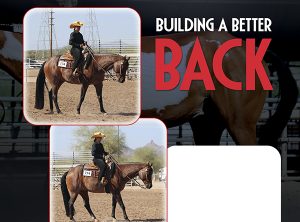Building A Better Back
Click here to read the complete article
150 – July/August, 2023
Perhaps no other maneuver is more overlooked when preparing for a pattern class than the back. Perfecting the challenging maneuvers –lead changes, square corners, transitions–is where exhibitors naturally focus their time and effort as those elements require more skill and strategy. But when it comes to the judges’ scoresheets, the back as its own maneuver is worth just as much as those more brow-raising pattern elements and is far too often an afterthought for exhibitors.
Sometimes used as a tiebreaker, the back–when done well–can appear smooth and effortless, but it can also be an ugly sticking point without proper preparation. Read on as trainers TR Potts, Amber Duckett, and Brittany Russell Brown share their knowledge and helpful hints to earn a higher score on the back maneuver.
But first, a look at the rule book
Before diving into the trainer tips, a look at the rule book can help exhibitors paint a mental picture of “the ideal.” The 2023 AQHA Official Handbook outlines the desirable attributes of the back under saddle. It describes a poor backup as “resistant and heavy in front. [The horse] may gap the mouth and throw his head or back crooked.” A horse performing an average back “backs straight and quietly with light contact and without hesitation.” And finally, a horse that would be credit-earning “displays balanced and smooth flowing movements. Backs straight with self-carriage without gap.” In the Horsemanship section of the rulebook, it is noted that “the back should be smooth and responsive;” and in Showmanship, “the horse should back up readily with the head, neck and body aligned in a straight or curved line as instructed.”
It sounds simple. But what exhibitors often expect to be a straightforward task–stop, back a prescribed number of steps and continue with the pattern–can result in some unexpected faux pas. Throwing the head, backing crooked, locking up, or attempting speed before the horse is ready are all frequent missteps. Add in the more challenging back maneuvers of backing arcs, L’s or serpentines, and things can get messy quickly!
A pleasing back is deceivingly difficult
Click here to read the complete article
150 – July/August, 2023











